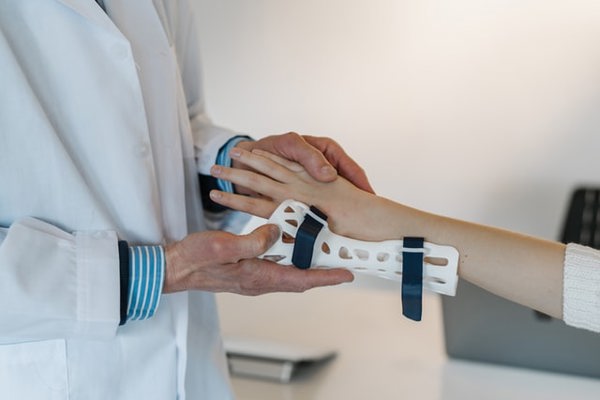
If you injure your hands or feet, like any other part of your body, you may be entitled to make a claim for compensation. In order to be successful in recovering compensation, someone else must be at fault for your accident. This may be an individual, a business, or a public body. For instance, if you injured your hand as a result of a road traffic accident, you may be entitled to make a compensation claim against the third-party driver. If you have injured your foot in an accident at work, you may be entitled to make a claim for compensation against your employer.
Structure of the Hand and Foot
The structure of the hands and feet are remarkably similar. By simply bending your fingers, you can easily see that each finger contains three bones, and that the thumb contains two. This is the same for your toes; each contains three bones with the exception of the big two which only have two. These finger and toe bones are known as phalanges.
The hand is comprised of a number of bones, muscles, nerves and ligaments that all work together to allow a very wide range of movement. There are twenty-seven bones in the hand, which can be divided into three main types. (1) The phalanges are the fourteen bones of the fingers and thumb. (2) The metacarpal bones are the bones that form the middle of the hand. (3) Finally, the carpal bones are the eight bones that create the wrist. The muscles of the hand contract and release to allow movement. The muscles are connected to the bones by tendons.
The structure of the foot is very similar. There are twenty-six bones in the foot, which are supported by muscles, tendons, and nerves. As with the hand, the foot can be divided into three distinct areas. (1) The forefoot describes the front area which is comprised of the phalanges (the fourteen toe bones), the metatarsal bones which are the five long bones that extend from the base of each toe to the midfoot, and the sesamoid bones which are two oval shaped bones embedded in the tendon at the base of the big toe which reduce stress on the tendon itself. (2) The midfoot is the area of the foot between the toes and the heel. It is comprised of five irregular shaped bones known as the tarsals which form the arch of the foot. The tarsals are responsible for stability and weight-bearing. (3) The hindfoot is made of two large bones: the calcaneus and the talus. The calcaneus is often referred to as the heel bone and transfers most of the body's weight from the legs to the ground. The talus sits between the heel and the ankle and assist with weight and pressure transfer from the ankle to the heel. Similarly, to the hand, there are muscles and tendons in the foot which provide movement and flexibility. The most well-known tendon in the foot, and one is very often injured, is the Achilles Tendon. This is discussed in my previous article looking at the value of ankle injuries.
Types of Hand and Foot Injury
The vast majority of hand and foot injuries can be categorised as either fractures or amputations.
A fracture is a break in the bone. Fractures can range from tiny hairline cracks to complete breaks that break the surface of the skin. Fractures to the foot and hand are most commonly caused by road traffic accident, slips or trips, or from accidents in the workplace. Fractures in the hand or foot can lead to long term problems with mobility and dexterity and can cause damage to nearby nerves. It’s important that broken bones in the hand are treated quickly, otherwise the bones may not heal in the proper alignment. This can lead to long terms issues with everyday activities. Those who have suffered from a fracture are at higher risk of developing conditions such as arthritis.
Amputation refers to the partial or complete removal of a body part such as a finger, toe, hand, foot, or a whole limb. Unsurprisingly, amputation can have a seriously detrimental effect on an individual's day-to-day life. Losing even one finger can greatly reduce an individual's ability to complete any number of tasks. Courts value the loss of a hand very similarly to the loss of a whole arm. The loss of a hand or foot may necessitate the need for a prosthetic in order for the individual to regain some mobility or dexterity.
Another common injury that may entitle you to compensation is dermatitis. Most commonly affecting the hands, dermatitis is type of skin irritation which is triggered by contact with a particular substance. This type of injury most often occurs in the workplace, often when employees haven't been provided with appropriate PPE. While the condition can often clear up itself, very serious cases require treatment and can last for several years, affecting employment and domestic capability.
What can you claim for?
If you have suffered a hand or foot injury, the amount of compensation a court may award you will depend on the severity of the injury and the effect it has had, and will continue to have, on your life. Some of the factors the court will look at when assessing the level of compensation are:
- The degree of pain experienced and the length of time it takes to make a full recovery;
- The effect of the injury on your everyday life and its long-term implications. This includes the ability to continue to work or take part in hobbies and activities previously enjoyed;
- Wage loss, both past and future, and whether any services have been required by family and friends;
- The extent of the treatment required, particularly whether surgery was needed; and
- Whether there was a pre-existing hand or foot problem and the extent to which this was exacerbated by the accident.
Our experienced personal injury solicitors will be able to quantify these factors and establish how much you are likely to receive in compensation.
What could your claim be worth?
If you have a claim for compensation, how much could you be awarded?
Morton Fraser's Compensation Calculator is a handy guide which can provide you with an indication of the value of your injury. It is based on the Judicial College Guidelines which take account of recent court decisions and serve as a reference point for lawyers when considering compensation. The recommended awards for hand and foot injuries are set out below.
Hand Injuries
- Minor hand injuries that include dislocation of the thumb, fractures which have recovered in six months, scarring, and tenderness are typically valued at £7,780 at most.
- More serious injuries to the thumb, such as those that involve the amputation of the tip, causing nerve damage or impairment of sensation or function attract awards between £12,590 and £16,760.
- The most serious thumb injuries are valued at between £16,760 and £54,830. This bracket includes total loss of thumb as well as injuries where the thumb has been amputated but reattached at the base, leaving it without movement. Total loss of the thumb would be placed at the higher end of the scale.
- For fractures to the finger, the Court generally makes awards between £10,320 and £16,340. Injuries which result in deformity or permanent loss of grip or dexterity will be valued at the higher end of the scale.
- Amputation of the little finger will attract awards between £8,640 and £12,240. Amputation of the ring and little fingers is valued in the region of £21,810.
- Moderate hand injuries including crush type injuries where surgery is required but has left the hand with permanent disability are usually valued between £5,720 and £13,280.
- Serious hand injuries such as those which reduce the hand to about 50% capacity, where several fingers have been amputated and reattached, leaving the hand unsightly and with reduced grip can attracts awards in the region of £29,000 to £61,910.
- Complete amputation of the index and middle and/or ring fingers leaving the hand with very little use may be valued between £61,910 and £90,750.
- Total or effective loss of one hand is often valued between £96,160 and £109,650. This bracket refers to injuries where the hand has been surgically amputated or where all fingers and most of the palm have been traumatically amputated. Awards at the higher end of the scale are to be expected where the damage is to the individual's dominant hand.
- For total or effective loss of both hands, the Court typically makes compensation awards of between £140,660 and £201,490. The top end of the bracket is reserved for injuries where the amputation has occurred in such a way that no effective prosthesis can be used.
- For dermatitis and other skin conditions, the Court would likely make an award between £1,710 and £19,200. Dermatitis of both hands which affects employment and has some psychological consequence lasting for some years would be valued more highly than irritation that resolves within a few months with treatment.
Foot Injuries
- Minor toe injuries such as straightforward fractures or the exacerbation of a pre-existing condition can attract awards up to £9,600.
- Injuries to the toes, including multiple fractures to toe or more toes, severe crush injuries, and the amputation of one or two toes (excluding the big toe) are usually valued between £13,740 and £21,070 depending on the severity.
- Injuries that require the amputation of the big toe are valued at around £31,310, whereas the amputation of all toes is valued between £36,520 and £56,080. The position within this range is determined by whether the amputation was surgical or traumatic, and the impact it has on the individual's mobility.
- For modest foot injuries, such as simple metatarsal fractures and ruptured ligaments, the Court generally makes awards up to £13,740. More complicated injuries that take a longer period to recover from are valued at the higher end of the range.
- Moderate to serious foot injuries can attract awards of between £13,740 and £39,200. This bracket is reserved for complex fractures and injuries that lead to continuing pain or increased risk of future arthritis, requiring prolong treatment.
- For severe foot injuries including fractures to both heels or feet with substantial restriction to mobility and permanent pain, the Court would usually make awards between £41,970 and £70,030.
- The most severe injuries resulting in permanent and severe pain or serious permanent disability, such as the traumatic amputation of the forefoot or loss of a substantial portion of the heel, reducing mobility grossly, typically attract awards between £83,960 and £109,650.
- Amputation of one foot is usually valued in the same range, between £83,960 and £109,650 whereas amputation of both feet is valued more highly at between £169,400 and £201,490
Morton Fraser has successfully recovered damages in a number of cases where individuals suffered hand and foot injuries following accidents at work, road traffic accidents, and as the result of slip/trip accidents. This includes cases where our clients were unable to continue with the job they carried out before their accident due to difficulties with their dexterity following injuries to their hand and/or foot. In those cases, we require to consider carefully how our client is going to earn a living in the future so that we can assess any future loss of earnings and the potential for a claim for future loss of employability to account for difficulties in gaining employment. This claim would also take into account the costs of training for a new role and the likelihood of securing employment in a different sector. We will work with clients to consider the position, often with the assistance of employment experts.
Who is the claim against?
Who is liable to pay compensation will depend upon the circumstances of the accident and who is to blame for your accident occurring. Many hand and foot injuries are caused as a result of slipping or tripping in the workplace for which your employer may be liable for if there has been a breach of duty. You may also be entitled to make a claim for medical negligence if your hand or foot injury is due to a surgical error, delayed treatment or misdiagnosis. Morton Fraser's Personal Injury Team has extensive experience in pursuing all types of claims and we can provide you with advice on who is liable to pay compensation once we have discussed the facts and circumstances of your claim.
What next?
The above guidelines and our Compensation Calculator provide an initial indication of the values a court may award for the 'pain and suffering' you have endured, but do not take into account other losses such as assistance you required following your accident, the cost of medical treatment, past and future wage loss, pension loss and any other expenses you have incurred as a result of the accident. Each individual case must be considered on its own facts and circumstances. Our experienced Personal Injury team will take the time to assess your claim and can help you get the compensation you are entitled to. Contact us today on 0131 247 1000 or through our personal injury compensation enquiry form.


